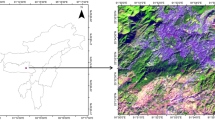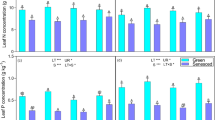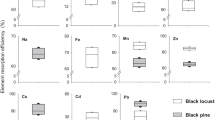Abstract
Forest canopy is a complex interface between the atmosphere, the biosphere and the lithosphere, exerting a strong influence on forest durability through element recycling. Leaves are filters of the low atmosphere and can capture dry deposition (DD). Trees have developed strategies, such as resorption (R) during senescence, for nutrient conservation. These strategies seem to depend on the soil type. The chemical composition evolution of leaves is conceptualized as a function of four fluxes: foliar absorption (FA) foliar leaching, (FL), accretion (A), and resorption (R). The objective of this study is to evaluate these five fluxes, i.e., DD, FA, FL, A, and R for different elements (N, P, K, S, Ca, Mg, Mn, and Si) at the experimental forest site in Montiers which includes three plots with contrasting soils and similar climate and stand characteristics. The percentage of resorption was 63% for N, 37% for S, 35% for K and 23% for P, regardless of the soil type. Resorption represents the most efficient recycling mechanism for ecosystems. Accretion during senescence occurs in two elements that are also found as biominerals in leaves: Ca (13–26 kg.ha−1.y−1) and Si (3–6 kg.ha−1.y−1). The effect of soil is limited to leaf concentrations and exchanges, and only for three elements (Mn, Ca and Si) that are not growth-limiting elements in our study site. This study shows that, except for N, taking into account the exchanges between living foliar tissues and leaching solutions is fundamental to accurately estimate the resorption rate.







Similar content being viewed by others
Data availability
Yes.
Code availability
Not applicable.
Abbreviations
- A:
-
Accretion; As: during senescence
- BD:
-
Bulk deposition
- CE:
-
Canopy exchange; CEs: during senescence
- DD:
-
Dust deposition (intercepted by the canopy: < 0.45 µm size)
- f e :
-
Enrichment factor
- f e(Ld):
-
Enrichment factor during leafed period
- f e(F):
-
Enrichment factor during leaf fall period
- f e(Ls):
-
Enrichment factor during leafless period
- FA:
-
Foliar absorption; FAs during senescence period
- GL:
-
Green leaves
- FL:
-
Foliar leaching, FLs during senescence
- LBS :
-
Leaf budget during senescence
- LL:
-
Litter leaves; LLs: during senescence
- R:
-
Resorption; Rs during senescence
- SD:
-
Stand deposition
- TE:
-
Tree exchange; TES during senescence
References
Achat DL, Pousse N, Nicolas M, Augusto L (2018) Nutrient remobilization in tree foliage as affected by soil nutrients and leaf life span. Ecol Monogr. 88:408–428
Aerts R, Chapin FS (2000) The mineral nutrition of wild plants revisited: a re-evaluation of processes and patterns. Adv Ecol Res 30:1–67
André F, Jonard M, Ponette Q (2008a) Influence of species and rain event characteristics on stemflow volume in a temperate mixed oak-beech stand. Hydrol Process 22:4455–4466
André F, Jonard M, Ponette Q (2008b) Spatial and temporal patterns of throughfall chemistry within a temperate mixed oak-beech stand. Sci Total Environ 397:215–228
Berg B, Mc Claugherty C (2014) Plant Litter: Decomposition, humus formation, carbon sequestration, 3rd edn. Springer-Verlag, Berlin Heidelberg
Birk EJ, Vitousek PM (1986) Nitrogen availability and nitrogen use efficiency in loblolly pine stands. Ecology 67:69–79
Bredemeier M (1989) Forest canopy transformation of atmospheric deposition. Water Air Soil Pollut. 40:121–138
Brumme R, Leimcke U, Matzner E (1992) Interception and uptake of NH4 and NO3 from wet deposition by above-ground parts of young beech (Fagus silvatica L.) trees. Plant Soil 142:273–279
Calvaruso C, Kirchen G, Saint-André L, Redon P-O, Turpault M-P (2017) Relationship between soil nutritive resources and the growth and mineral nutrition of a beech (Fagus sylvatica) stand along a soil sequence. CATENA 155:156–169
Chapin FS (1980) The mineral nutrition if wild plants. Annu Rev Ecol Syst 11:233–260
Chapin FS, Moilanen L (1991) Nutritional controls over nitrogen and phosphorus resorption from Alaskan Birch leaves. Ecology 72:709–715
de Vries W, Reinds GJ, Deelstra HD, Klap JM, Vel EM (1999) Intensive monitoring of forest ecosystems in Europe; technical report 1999. EC-UN/ECE, Brussels, Geneva
Dincher M, Calvaruso C, Turpault M-P (2020) Major element residence times in humus from a beech forest: The role of element forms and recycling. Soil Biol Biochem 141:107674
Draaijers GPJ, Erisman JW, van Leeuwen NFM, Römer FG, te Winkel BH, Veltkamp AC, Vermeulen AT, Wyers GP (1997) The impact of canopy exchange on differences observed between atmospheric deposition and throughfall fluxes. Atmos Environ 31:387–397
Duchesne L, Ouimet R, Camiré C, Houle D (2001) Seasonal nutrient transfers by foliar resorption, leaching, and litter fall in a northern hardwood forest at Lake Clair Watershed, Quebec, Canada. Can J For Res 31:333–344
Eisalou HK, Şengönül K, Gökbulak F, Serengil YU, B, (2013) Effects of forest canopy cover and floor on chemical quality of water in broad leaved and coniferous forests of Istanbul. Turkey For Ecol Manage 289:371–377
FAO (2016) World reference base for soil resources 2014, World Soil Resources Report 106. FAO, Rome
Ferm M (1993) Throughfall measurements of nitrogen and sulphur compounds. Int J Environ Anal Chem 50:29–43
Fichter J, Dambrine E, Turpault MPR, J, (1998) Base cation supply in spruce and beech ecosystems of the Strengbach catchment (Vosges mountains, N-E France). Water Air Soil Pollut 104:125–148
Fillion N, Probst A, Probst JL (1999) Dissolved organic matter contribution to rain water, throughfall and soil solution chemistry. Analysis 27:409–413
Filoso S, Williams MR, Melack JM (1999) Composition and deposition of throughfall in a flooded forest archipelago (Negro River, Brazil). Biogeochemistry 45:169–195
Hagen-Thorn A, Varnagiryte I, Nihlgard B, Armolaitis K (2006) Autumn nutrient resorption and losses in four deciduous forest tree species. For Ecol Manage 228:33–39
Helmisaari HS (1992) Nutrient retranslocation within the foliage of Pinus sylvestris. Tree Physiol 10:45–58
Hofhansl F, Wanek W, Drage S, Huber W, Weissenhofer A, Richter A (2011) Topography strongly affects atmospheric deposition and canopy exchange processes in different types of wet lowland rainforest, Southwest Costa Rica. Biogeochemistry 106:371–396
Johnson DW, Linberg SE (1992) Atmospheric deposition and nutrient cycling in forest ecosystems. Springer-Verlag, New York, A Synthesis of the Integrated Forest Study
Kirchen G, Calvaruso C, Granier A, Redon P-O, Van der Heijden G, Bréda N, Turpault M-P (2017) Local soil type controls the water budget and stand productivity in a beech forest For Ecol. Manage 390:89–103
Kopáček J, Turek J, Hejzlar JŠ, H, (2009) Canopy leaching of nutrients and metals in a mountain spruce forest. Atmos Environ 43:5443–5453
Lal CB, Annapurna C, Raghubanshi AS, Singh JS (2001a) Effect of leaf habit and soil type on nutrient resorption and conservation in woody species of a dry tropical environment. Can J Bot 79:106–1075
Lal CB, Annapurna C, Raghubanshi AS, Singh JS (2001b) Foliar demand and resource economy of nutrients in dry tropical forest species. J Veg Sci 12:5–14
Lequy E, Calvaruso C, Conil S, Turpault MP (2014) Atmospheric particulate deposition in temperate deciduous forest ecosystems: Interactions with the canopy and nutrient inputs in two beech stands of Northeastern France. Sci Total Environ 487:206–215
Lindberg SE, Lovett GM, Richter DD, Johnson DW (1986) Atmospheric deposition and canopy interactions of major ions in a forest. Science 231:141–145
Mayer R, Ulrich B (1977) Acidity of precipitation as influenced by the filtering of atmospheric sulphur and nitrogen compounds - its role in the element balance and effect on soil. Water Air Soil Pollut. https://doi.org/10.1007/BF00284135
Michalzik B, Stadler B (2005) Importance of canopy herbivores to dissolved and particulate organic matter fluxes to the forest floor. Geoderma 127:227–236
Miller HG, Cooper JM, Miller JD, Pauline OJL (1979) Nutrient cycles in pine and their adaptation to poor soils. Can J For Res 9:19–26
Niinemets U, Tamm U (2005) Species differences in timing of leaf fall and foliage chemistry modify nutrient resorption efficiency in deciduous temperate forest stands. Tree Physiol 25:1001–1014
Nordén U (1991) Acid deposition and throughfall fluxes of elements as related to tree species in deciduous forests of South Sweden. Water Air Soil Pollut 60:209–230
Parker GG (1983) Throughfall and stemflow in the forest nutrient cycle Adv. Ecol Res 13:57–133
Parraga-Aguado I, Querejeta JI, Gonzalez-Alcaraz MN, Conesa HM (2014) Metal(loid) allocation and nutrient retranslocation in Pinus halepensis trees growing on semiarid mine tailings. Sci Total Environ 485–486:406–414
Pelster DE, Kolka RK, Prepas EE (2009) Overstory vegetation influence nitrogen and dissolved organic carbon flux from the atmosphere to the forest floor: Boreal Plain. Canada For Ecol Manage 259:210–219
Pryor SC, Barthelmie RJ (2005) Liquid and chemical fluxes in precipitation, throughfall and stemflow: observations from a deciduous forest and a Red Pine plantation in the Midwestern USA. Water Air Soil Pollut 163:203–227
Qualls RG, Haines BL, Swank WT, Tyler SW (2000) Soluble organic and inorganic nutrient fluxes in clearcut and mature deciduous forests. Soil Sci Soc Am J 64:1068–1077
Sommer M, Jochheim H, Höhn A, Breuer J, Zagorski Z, Busse J, Barkusky D, Meier K, Puppe D, Wanner M, Kaczorek D (2013) Si cycling in a forest biogeosystem – the importance of transient state biogenic Si pools. Biogeosciences 10:4991–5007
Stachurski A, Zimka JR (1975) Methods of studying forest ecosystems: leaf area, leaf production and withdrawal of nutrients from leaves of trees. Ekologia Polska 33:637–648
Staelens J, De Schrijver A, Verheyen K (2007) Seasonal variation in throughfall and stemflow chemistry beneath a European beech (Fagus sylvatica) tree in relation to canopy phenology. Can J For Res 37:1359–1372
Staelens J, Houle D, De Schrijver A, Neirynck J, Verheyen K (2008) Calculating dry deposition and canopy exchange with the canopy budget model: review of assumptions and application to two deciduous forests. Water Air Soil Pollut 191:149–169
Talkner U, Krämer I, Hölscher D, Beese FO (2010) Deposition and canopy exchange processes in central-German beech forests differing in tree species diversity. Plant Soil 336:405–420
Thimonier A, Schmitt M, Waldner P, Rihm B (2005) Atmospheric Deposition on Swiss Long-Term Forest Ecosystem Research (LWF) Plots. Environ Monit Assess 104:81–118
Thomas H, Stoddart JL (1980) Leaf Senescence. Ann Rev. Plant Physiol 31:83–111
Tsujii Y, Onoda Y, Kitayama K (2017) Phosphorus and nitrogen resorption from different chemical fractions in senescing leaves of tropical tree species on Mount Kinabalu, Borneo. Oecologia 185:171–180
Turpault M-P, Calvaruso C, Kirchen G, Redon P-O, Cochet C (2018) Contribution of fine tree roots to the silicon cycle in a temperate forest ecosystem developed on three soil types. Biogeosciences 15:2231–2249
Tyler G (1976) Soil factors controlling metal ion absorption in the wood anemone Anemonenemorosa. Oikos 27:71–80
Ulrich B (1983) Interaction of Forest Canopies with Atmospheric Constituents: So2, Alkali and Earth Alkali Cations and Chloride. In: Ulrich B (ed) Effects of accumulation of air pollutants in forest ecosystems. Springer, Dordrecht, pp 33–45
Ulrich E, Lanier M, Combes D (1998) RENECOFOR - Dépôts atmosphériques, concentrations dans les brouillards et dans les solutions du sol (sous-réseau CATAENAT) - Rapport scientifique sur les années 1993 à 1996. Office National des Forêts, Département des Recherches Techniques
van Heerwaarden LM, Toet S, Aerts R (2003) Nitrogen and phosphorus resorption efficiency and proficiency in six sub-arctic bog species after 4 years of nitrogen fertilization. J Ecol 91:1060–1070
Van Stan JT, Pypker TG (2015) A review and evaluation of forest canopy epiphyte roles in the partitioning and chemical alteration of precipitation. Sci Total Environ 536:813–824
Vergutz L, Manzoni S, Porporato A, Novais RF, Jackson RB (2012) Global resorption efficiencies and concentrations of carbon and nutrients in leaves of terrestrial plants. Ecol Monogr 82:205–220
Vitousek P (1982) Nutrient cycling and nutrient use efficiency. Am Nat 119:553–572
Yawney HW, Leaf AL, Leonard RE (1978) Nutrient content of throughfall and stemflow in fertilized and irrigated Pinus resinosa ait. Stands Plant Soil 50:433–445
Acknowledgement
The authors would like to thank the technical staff of INRA-BEF and ANDRA for field sampling, and in particular Serge Didier as technical manager of the Montiers site. We are particularly grateful to Carine Cochet, Claire Pantigny, and Véronique Sagres for the numerous solution and leave analyses. We are also grateful to Météo-France for the communication of meteorological data. We thank ANDRA, INRAE, GIP Ecofor and AnaEE France for the financial functioning of the Montiers site. We would like to acknowledge the National Forest Office (ONF) for welcoming us into the domanial forest of Montiers.
Funding
No.
Author information
Authors and Affiliations
Corresponding author
Ethics declarations
Conflict of interest
No.
Ethics approval
Yes.
Consent to participate
Yes.
Consent for publication
Yes.
Additional information
Responsible Editor: Justin B. Richardson
Publisher's Note
Springer Nature remains neutral with regard to jurisdictional claims in published maps and institutional affiliations.
Electronic supplementary material
Relationship between the percentage of soluble elements and the percentage of CEs. Below is the link to the electronic supplementary material.

Rights and permissions
About this article
Cite this article
Turpault, MP., Kirchen, G., Calvaruso, C. et al. Exchanges of major elements in a deciduous forest canopy. Biogeochemistry 152, 51–71 (2021). https://doi.org/10.1007/s10533-020-00732-0
Received:
Accepted:
Published:
Issue Date:
DOI: https://doi.org/10.1007/s10533-020-00732-0




